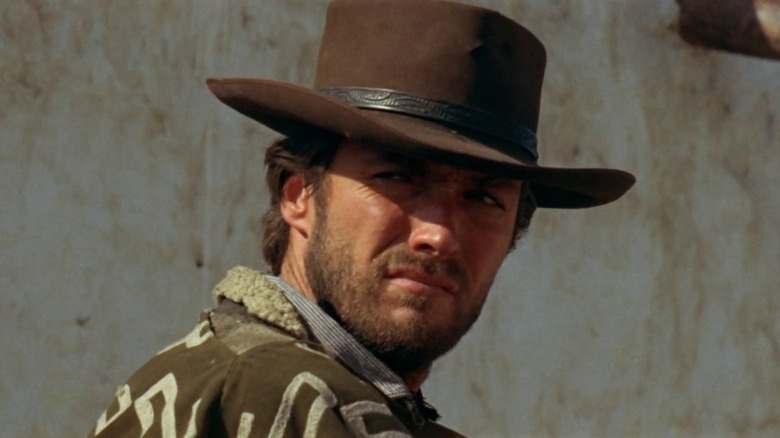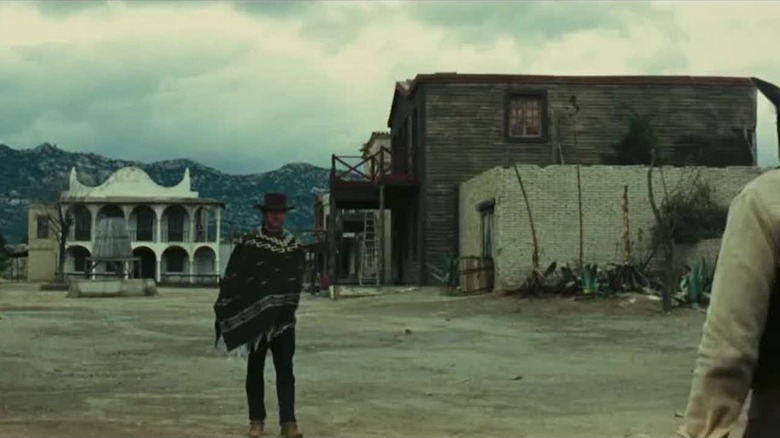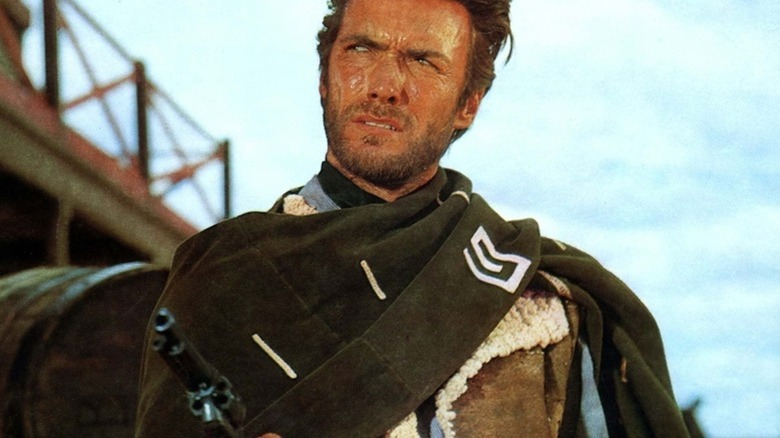The 60s Western That Helped Launch Clint Eastwood To Stardom
Clint Eastwood was already 30 years old when he landed his breakout role in the CBS Western "Rawhide." The actor had spent much of the 1950s getting by on bit parts in B movies (most notably the Jack Arnold monster duo of "Revenge of the Creature" and "Tarantula"), and guest roles on TV series like "Maverick" and "Death Valley Days," so you'd think he would've been thrilled. But Eastwood was displeased with his character Rowdy Yates, who, early on in the series' run, was a wet-behind-the-ears ramrod. At his age, he was eager to play a grown, capable man with enough years behind him to allow for a bit of mystery.
Eastwood's restlessness coincided with a shift in filmmakers' approach to the Western genre. Though maestros like John Ford, Howard Hawks, Anthony Mann, and Budd Boetticher had allowed for moral ambiguity in their movies, the vast majority of Westerns were white hat/black hat affairs that ended with the upholding of law and order. The term "riding off into the sunset" was coined to reflect the predictably rosy outcomes of these films.
But as the United States entered the 1960s, audiences had grown weary of this rigid formula. With the Civil Rights Movement in full swing and the Vietnam War expanding, moviegoers were questioning the triumphal narrative of American history in general, and the taming of the West in particular. You had to be a violent and not-entirely-virtuous person to survive, much less thrive in this realm.
So when Eastwood was offered the opportunity to make an unusually violent, low-budget Western in Spain with an unknown Italian director, he seized it. In doing so, he radically transformed the moribund genre and became a gunslinging icon.
Clint Eastwood 'decided it was time to be an antihero'
Sergio Leone began his career as director Vittorio De Sica's assistant on the Italian Neorealism classic "The Bicycle Thieves," and established himself as a capable AD on Rome's Cinecettà Studios lot, where massive Hollywood epics like "Quo Vadis" and "Ben-Hur" were shot. His first feature, "The Colossus of Rhodes," was a cheaply produced knockoff of these swords-and-sandals sagas, and performed well enough at the box office to earn him a second go-round behind the camera. He chose the Western "A Fistful of Dollars" as his next project.
There are varying accounts regarding the development of "A Fistful of Dollars," with several people claiming credit for having hatched the idea. All that matters is that a bunch of Italian filmmakers (including Leone) saw Akira Kurosawa's "Yojimbo," and thought the story of a rogue samurai manipulating two vicious clans, which are terrorizing a small village's citizenry, into wiping each other out would make for an entertaining Western.
"Yojimbo" itself was an unofficial adaptation of Dashiell Hammett's 1929 crime novel "Red Harvest," so these instincts were spot on. All Leone needed was an American star so that the movie could be widely distributed in the U.S. He initially aimed high, courting Henry Fonda and Charles Bronson; alas, the former was too expensive, while the latter loathed the screenplay. Leone's set his sights fairly low – like Steve Reeves/Rory Calhoun low — before getting a taker in Eastwood. "In 'Rawhide,' I did get awfully tired of playing the conventional white hat," said Eastwood. "The hero who kisses old ladies and dogs and was kind to everybody. I decided it was time to be an antihero."
The Western would never be the same — though it would take a while for this seismic cinematic event to rock the U.S.
The Spaghetti Western revolution of 1967
Eastwood's portrayal of the "Man with No Name" was a shocking departure from the Western heroes made famous by John Wayne, James Stewart, and Gary Cooper. Sure, Wayne could be laconic, but Eastwood's character was a man of almost no words. His stubbly protagonist's past is unknown; he's just a guy who wears a rumpled poncho, chomps on cheroot cigars and, when the time comes, outguns every cretin who draws down on him.
Though the film is nowhere near as visually distinguished as Leone's subsequent collaborations with Eastwood ("For a Few Dollars More" and "The Good, the Bad and the Ugly"), "A Fistful of Dollars" set the template for the Spaghetti Western via its tight, widescreen close-ups and Ennio Morricone's yowling, electric guitar-laced score. Watch the film today, and you won't be able to go more than a few minutes before hitting a moment that's been copied to death over the last 60-plus years.
"A Fistful of Dollars" was a hit in Europe upon its release in 1964, but it wouldn't receive distribution in the United States until 1967 (due to concerns of Kurosawa filing a lawsuit). By this point, Eastwood and Leone had completed the other two films in the "Dollars trilogy," so the Spaghetti Western phenomenon hit all at once. By the end of the year, all three movies were in theaters and doing terrific box office. The vanilla heroics of Rowdy Yates were effectively wiped from moviegoers' memories. Eastwood was a new, morally complex kind of Western hero, and he would revise and subvert this image for decades to come.


